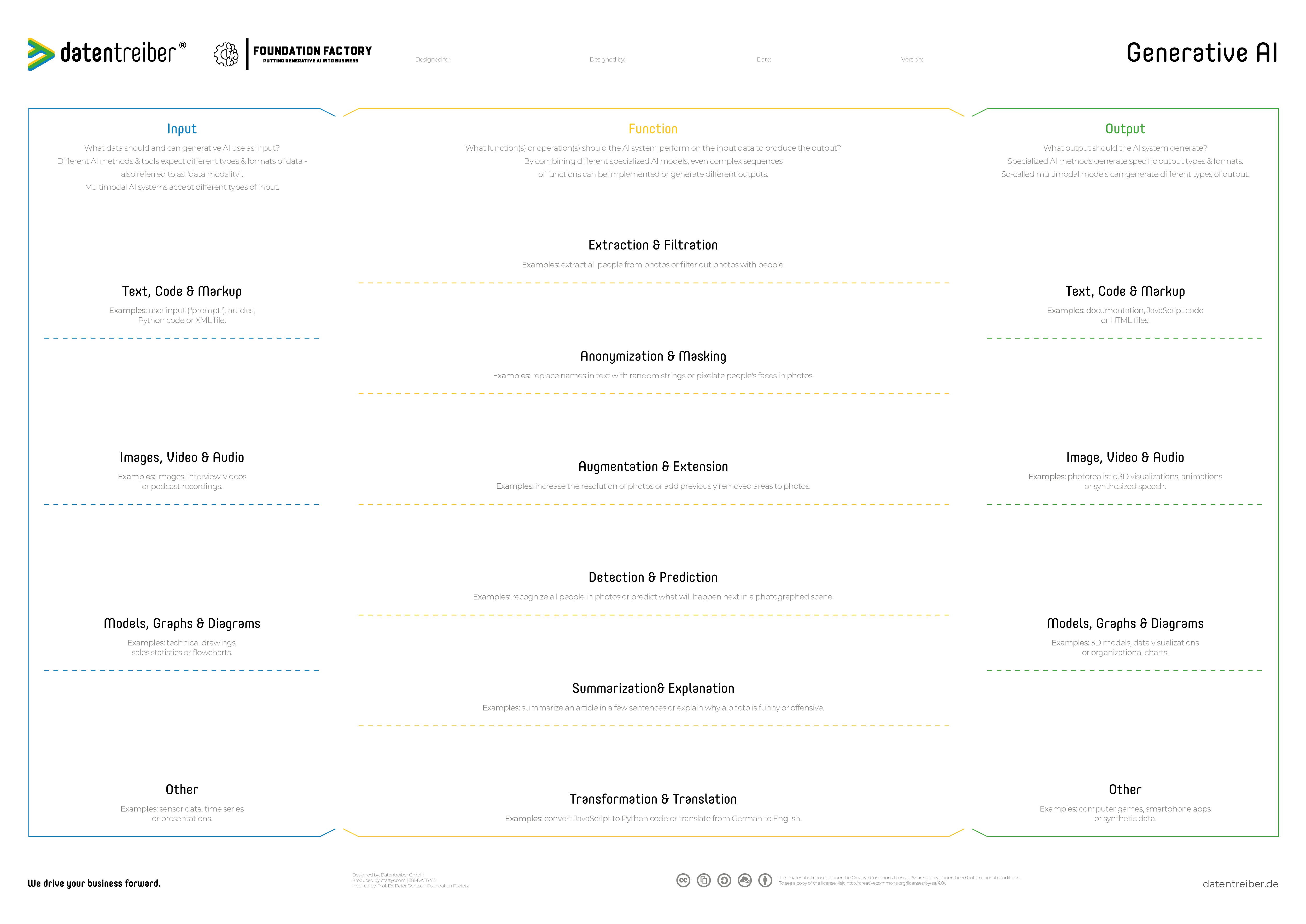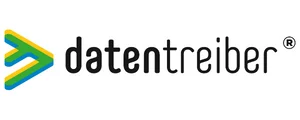
Generative AI Canvas
With the Generative AI canvas, you develop creative and innovative application ideas of Generative AI for your company and your customers. The canvas shows you the business potential of your data and the diverse possibilities of Artificial Intelligence.
We drive your business forward.
What Is the Generative AI Canvas?
The Generative AI canvas helps in use case ideation for Generative AI by providing three starting points as a source of inspiration:
- Input: What data do we already have available as a company or could we provide, which can be used as input for a generative AI (also in combination)? The canvas distinguishes between different types of data: character-based data such as text, code, and markup; audiovisual data such as images, videos, and audio; graph-based data such as models, drawings, and diagrams.
- Function: what functions can a Generative AI perform on the input data (individually, sequentially, or in parallel) to generate new data or content? The possible functions can be categorized as extraction & filtering, anonymization & masking, enhancement & augmentation, detection & prediction, summarization & explanation, and transformation & translation.
- Output: what content do we or our customers want as a generated result? Again, the canvas distinguishes the types of data mentioned in the input – also called modalities. A multimodal AI can process and output different types of data.
The Generative AI canvas is available for free under a Creative Commons-License: you may use and modify the canvas as long as you cite data drivers and the AI Foundation as a source in particular.
We drive your business forward.

We drive your business forward.
How Do I Use the Generative AI Canvas?
The Generative AI canvas helps you to generate application ideas for Generative AI in interdisciplinary teams. To do this, you run through the canvas twice: the first time from left to right and the second time from right to left.
On colored sticky notes, note the input or output data and the functions on the data: green for existing data or available functions, red for missing data or functions, and yellow for planned or in-progress data or functions.
Connect the input data, functions, and output data with arrows (on transparent notecards). A Generative AI solution can process multiple data sources and execute multiple functions side-by-side or in sequence, so it can also produce different outputs.
Iteration: Start With the Input
Get an overview of the existing data sets in your company. Think not only of structured data, but especially of unstructured data such as documents (text, code & markup files), media streams (images, audio & video) or technical documents (diagrams, drawings, models, images etc.). Use the Data Landscape canvas as another tool if necessary. An input can also be a user input of commands and parameters for the AI, called a “prompt”.
Then consider what functions are possible and useful from that input data – and what the result of that function is. For example, a Generative AI might convert a textual description of a building into a photograph, a 3D model, or an engineering drawing. Also note the possible outputs.
Iteration: Start With Output
Start the second round by asking what content the company or customers desire and write down the ideas on the right side under “Output”. Then, consider what functions are necessary to achieve this output and what inputs are required for it.
For example, a customer’s request could be that there is a textual description for every product. A generative AI could generate a summary based on the product photos for this purpose.
We drive your business forward.
Where Can I Find More Information?
You can find more documents here:
- AI for Creatives: The Generative AI Canvas (Blog)
- Data Thinker-Gruppe (LinkedIn)
The Generative AI canvas was developed in collaboration with the Foundation Factory. On the pages of the AI Foundation you can find more information about Generative AI.
We drive your business forward.
How Can I Start?
Seminars

Get to know our Data Strategy Design Method in our practical seminars:
- For beginners: Data Strategy & Culture
- For rising stars: Data Design Thinking
- For advanced designers: Data Business Consulting
Cross References

Here you can find further canvas and information concerning Data Strategy Design:
License Terms

You are free to:
Share — copy and redistribute the canvas in any medium or format
Adapt — remix, transform, and build upon the canvas
for any purpose, even commercially.
Under the following terms:
Attribution
ShareAlike
We drive your business forward.
Subscribe to our newsletter:
Receive all relevant blog articles, new seminar dates, special conference offers and much more conveniently by email. As a welcome gift, we will send you a link to download our Datentreiber design book (in German) and, for a short time, the article ” Data Thinking: mehr Wert aus Daten” in PDF form after your registration.
By clicking ‘Subscribe to our newsletter’ you agree that we process your information in accordance with our privacy policy.


